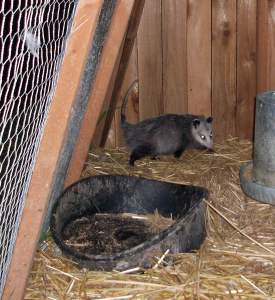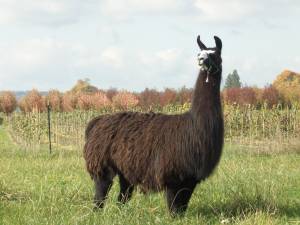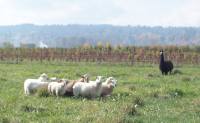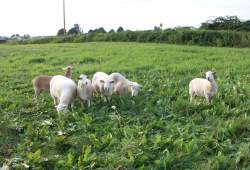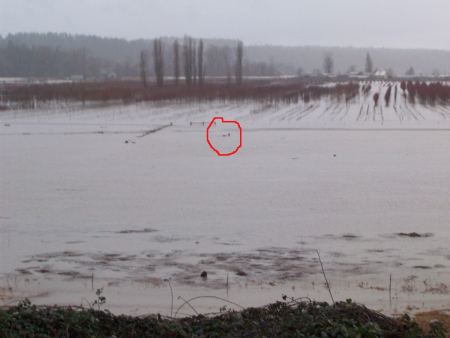
Today was a pretty challenging day! The flood gauges were getting high, and we tried to move the sheep last night, but they didn’t want to go out of the field in the dark. We waited til this morning, and I was able to move them smoothly and with little fanfare to their pen up by the house. Phew.
But, the llama was a different story. She has been getting more wilyas the weeks go on. We’ve caught her a couple of times, just handled her a little, and then let her go. But, each time, she remembers what we did last time and she won’t let us do that again. Today, she was not to be convinced to leave the pasture, let alone caught. I opened up all the gates and tried to push her through with Maggie. No go. Later, our neighbor Dan and both my parents came over– the four of us tried to make her go through a gate- any gate-no way. I brought sheep #33 down and tried to lure her up. She called to the sheep, but still refused to budge. If anyone would get within 100 feet of her, she’d just bolt past and run to the other end of the pasture. Running in front of her waving hands, etc did not work, she’d obviously run over someone if she had to, to get where she was going. She is one stubborn animal!
I went to work briefly this morning, but came home around 11 because flooding looked imminent. Sure enough, the dikes were just over-topping. The best I could hope for was that the llama’s wily instincts would kick in when the water stared flowing into the pasture, and she’d fiind an open gate, and head for higher ground and her sheep. The flood waters were proceeding really slowly across the valley for a couple of hours.
But then things turned for the worse, water started coming fast, and surrounded her in the pasture. She stayed put at a high spot until the water was up to her back, and then she started to swim. Our neighbor Dan brought out his canoe and went out to try to help her. By this time, water started rushing over the road and making a focal point of current, with a several-foot waterfall on the other side with rough-looking rapids.
The llama got caught up on the fence by the road for a few minutes, and as Dan tried to help her, she got free and was pulled by the current over the road. She almost gained her footing there in the shallower water, but the current got the best of her, and she went tumbling through the rapids, her skinny little legs kicking in the air upside-down. Ugh! It was hard to watch. There was a large crowd by this time, and we all gasped.
But she came right back up and started swimming on the other side. Dan re-launched his canoe on the other side of the road, reached her, and managed to to guide her near to the edge of the water where she could stand up. Kirk and several guys ran down to help. Dan had a leadrope on her halter. But that’s when she started to get stubborn again, or hypothermic and shock-ey, it’s hard to know which. She kept “kushing” or lying down, refusing to move. She was getting floppy, so the guys finally flipped her into the canoe upside-down and towed her to dry land! Keep in mind that they were all standing knee deep, and deeper, in very cold water! Kirk and Dan had hip-waders on, but some of the other guys were in tennis shoes and blue jeans! I was worried, but people seemed to be willing to risk their own lives to save this llama!
When they got her to the edge, a whole bunch of people helped carry her up to the road. Some people brought blankets and a horse blanket to warm her. We pushed and pulled and prodded, and she was not helping the whole way, she just wanted to lie down. I racked my brain to think of the quickest way we could warm her, and realized that my van was the answer– I could drive it right down to her, and crank up the heat, and we could warm her much quicker than any building. So, that’s what we did, with one last big heave-ho.
I put hot water bottles in her armpits and near her thighs. I put a heating pad under her chest, and Kirk ran a blow dryer on her head. There was a bale of hay in the van, and she started snacking within a few minutes, and then getting annoyed with us a few minutes after that, throwing her head around and laying her ears back. So some part of me thinks she was faking her hypothermia and she was actually fine, just tired and traumatized, and probably afraid of all those people. We left her in there for a few hours to continue to warm up and rest, until her skin was toasty-warm to the touch.
My parents rigged up a stall in their barn with lots of straw and two brooder lamps, and we left her there in the evening with the horse blanket draped over her. They said she seemed fine at 9pm when they checked on her. So, now I suppose the biggest concern would be if she aspirated water and is at risk for pneumonia or something. But she seems to be out of the woods. Probably just tired and bruised up.
There were some funny moments. One lady kept trying to feed her a carrot- but a carrot was the last thing she wanted after nearly dying! It’s funny what people do under stress, when they want desperately to help, or make things OK. And, a mouse was riding on her head while she was swimming, and later, a dead mouse fell out of her wool! There were mice swimming everywhere out there, and we even saw a salmon swim by!
Lucky llama that there were so many people there to help. It really took a crew, and Dan’s canoe, to pull it off. I’m not sure what her future will be with us– if she is this recalcitrant, she may not have a place at our farm. We need our livestock to move agreeably when there is a flood. I never expected to have an animal be so difficult to move or even get through a huge gate into a big, open space. I’m almost afraid to let her back out there in the pasture again, knowing there is no way to catch her or get her to leave the pasture. Oh, boy, we’ll see. At least I have a week or so to think, while the waters recede.
Meanwhile, we have ocean-front property; our house is safe on the hill, but we now look out on a valley full of water! This has been a wild weather year for Washington!
 Wow, we have a lot of snow– at least for us. I think it’s about a foot deep. Which, I’m sure, seems trivial to people in the Midwest or the East. But in the Northwest, that is a ton– I don’t have many memories of there being this much snow here in my lifetime. We’ve had snow falling for the last week, and more in the forecast for the whole next week- incredible! Usually it doesn’t stick around more than a day or two before melting into a muddy slop. Here is a panoramic photo from the pasture, in which Maggie appears twice– she got in the frame more than once!
Wow, we have a lot of snow– at least for us. I think it’s about a foot deep. Which, I’m sure, seems trivial to people in the Midwest or the East. But in the Northwest, that is a ton– I don’t have many memories of there being this much snow here in my lifetime. We’ve had snow falling for the last week, and more in the forecast for the whole next week- incredible! Usually it doesn’t stick around more than a day or two before melting into a muddy slop. Here is a panoramic photo from the pasture, in which Maggie appears twice– she got in the frame more than once!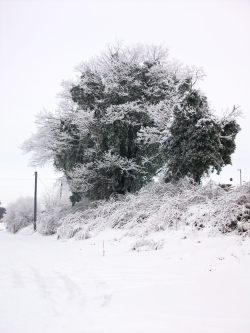 The temperatures aren’t bad– a few days it’s gotten into the teens, but it’s mostly hovering right around freezing. We got our first official complaint to animal control about our animals- from a well-meaning citizen who felt concerned for them. An animal control officer came out to investigate, and chuckled to himself, “well, the DO have wool, after all!” A friend of mine teased me that we should get wool coats for them!
The temperatures aren’t bad– a few days it’s gotten into the teens, but it’s mostly hovering right around freezing. We got our first official complaint to animal control about our animals- from a well-meaning citizen who felt concerned for them. An animal control officer came out to investigate, and chuckled to himself, “well, the DO have wool, after all!” A friend of mine teased me that we should get wool coats for them!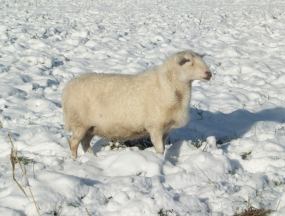 They really look like they’ve grown more wool in the last week or two, they are quite bundled up and puffy. The llama has so much wool insulating her that snow accumulates on her back and stays there– it doesn’t melt! Once a day I break the ice out of their trough with a pickaxe, though I suspect they are getting their water from eating snow and not going to the trough.
They really look like they’ve grown more wool in the last week or two, they are quite bundled up and puffy. The llama has so much wool insulating her that snow accumulates on her back and stays there– it doesn’t melt! Once a day I break the ice out of their trough with a pickaxe, though I suspect they are getting their water from eating snow and not going to the trough.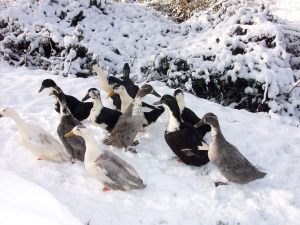
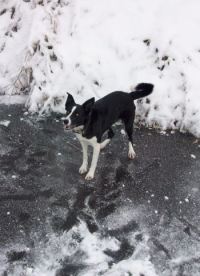
 I mentioned a while back I was shopping for sheep management software and having trouble deciding on (and finding) a product. Since I have such a small flock to start with, it almost seemed silly to need software. But, I am a software engineer, after all, so I like software to organize things. I considered using an Excel spreadsheet to track my animals, and that would work, for a while anyway. But I just saw a lot of limitations to that approach– taking multiple notes on animals, keeping track of pedigrees, and assessing potential inbreeding would not be feasible in Excel.
I mentioned a while back I was shopping for sheep management software and having trouble deciding on (and finding) a product. Since I have such a small flock to start with, it almost seemed silly to need software. But, I am a software engineer, after all, so I like software to organize things. I considered using an Excel spreadsheet to track my animals, and that would work, for a while anyway. But I just saw a lot of limitations to that approach– taking multiple notes on animals, keeping track of pedigrees, and assessing potential inbreeding would not be feasible in Excel.